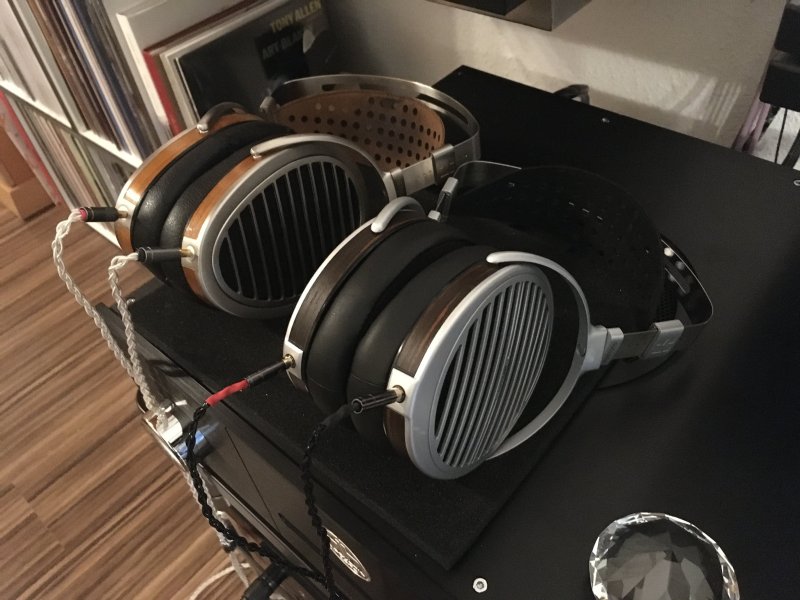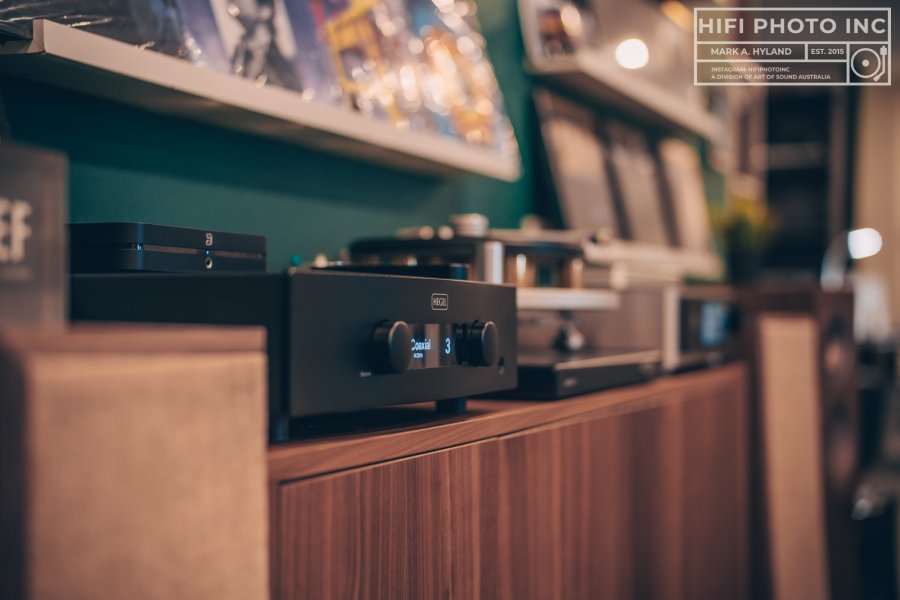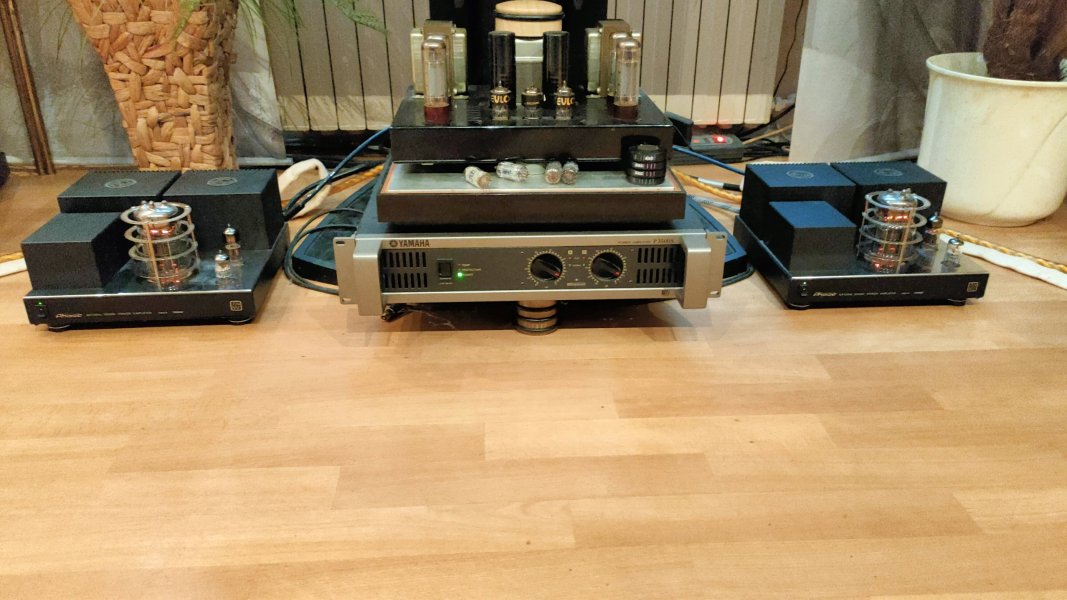Love taking pics of the gear
- Thread starter Synaxis
- Start date
You are using an out of date browser. It may not display this or other websites correctly.
You should upgrade or use an alternative browser.
You should upgrade or use an alternative browser.
What bias voltage (current)used at overture?
Did you use multimeter or oszilloskop? Thanks..
Multimeter measuring DC voltage.
set to a resolution of 2000.
For Overture and Melius,
Kondo state 0.5 mV to 0.55 mV.
But in reality I couldn't get those numbers.
I thought I had a faulty multimeter, so I tried with another and got the same numbers.
With the old tubes turning the potentiometer all the way down and almost all the way up (I was afraid to burn the tubes), I got 0.03 mV to 0.2 mV.
Tried some EL34 NOS I had... same thing.
I bought brand new Mullard EL34s (not NOS), and I got a minimum of 0.078 mV and a maximum of 0.2 mV.
So I couldn't rely on Kondo's procedure.
I would have to use my ears.
I noticed that adjusting 1 potentiometer affects all the other 3 in a way that it's lowering the voltage or increasing it.
For the last couple of weeks, I think I adjusted the bias about 4-5 times because something wasn't quite right with the SQ.
which can be so tedious as the overture has so many screws... and now I think I have become a master in it.
With the Kondo Overture, if you pin your ear to the woofers, you hear complete silence! with almost no hum, which is amazing for a tube amp!
So there were a couple of variables to get the best sound from the Overture:
- My ears.
- Leaving the amp powered on for more than 30 min (Kondo procedure state 15 min is enough).
- the slightest woofer hum in one of the speakers (there is always one that hums if the voltage is too low or too high).
- Tweaking the potentiometers for the most stable and exact voltage in all 4 tubes.
As I mentioned, tweaking 1 potentiometer affects all the others.
The best SQ with dead silent hum in both of the speakers, I got with 0.088 mV with the new Mullard EL34.
I can confidently testify that the overture now sounds the best it has ever been!!
and with new tubes, only one word come to mind, 'pristine' sound.
Attachments
Last edited:
Republicoftexas69
Well-Known Member
Lovely piece of wood.
Normally you have to be able to measure and set the required voltage on both legs of the 10 ohm cathode measuring resistor. Since the amplifier only provides a negative grid bias for all four tubes, the values always change when you adjust one tube for the another tubes.It may take a while until you have everything symmetrical.Multimeter measuring DC voltage.
set to a resolution of 2000.
For Overture and Melius,
Kondo state 0.5 mV to 0.55 mV.
But in reality I couldn't get those numbers.
I thought I had a faulty multimeter, so I tried with another and got the same numbers.
With the old tubes turning the potentiometer all the way down and almost all the way up (I was afraid to burn the tubes), I got 0.03 mV to 0.2 mV.
Tried some EL34 NOS I had... same thing.
I bought brand new Mullard EL34s (not NOS), and I got a minimum of 0.078 mV and a maximum of 0.2 mV.
So I couldn't rely on Kondo's procedure.
I would have to use my ears.
I noticed that adjusting 1 potentiometer affects all the other 3 in a way that it's lowering the voltage or increasing it.
For the last couple of weeks, I think I adjusted the bias about 4-5 times because something wasn't quite right with the SQ.
which can be so tedious as the overture has so many screws... and now I think I have become a master in it.
With the Kondo Overture, if you pin your ear to the woofers, you hear complete silence! with almost no hum, which is amazing for a tube amp!
So there were a couple of variables to get the best sound from the Overture:
- My ears.
- Leaving the amp powered on for more than 30 min (Kondo procedure state 15 min is enough).
- the slightest woofer hum in one of the speakers (there is always one that hums if the voltage is too low or too high).
- Tweaking the potentiometers for the most stable and exact voltage in all 4 tubes.
As I mentioned, tweaking 1 potentiometer affects all the others.
The best SQ with dead silent hum in both of the speakers, I got with 0.088 mV with the new Mullard EL34.
I can confidently testify that the overture now sounds the best it has ever been!!
and with new tubes, only one word come to mind, 'pristine' sound.

Very important when measuring: fit a short-circuit plug to the RCA input and connect 8 ohm load resistors to the speaker terminals. Tube amplifiers always need a load, otherwise they may be destroyed. Important equipment: gripping clips, multimeter, short plugs and load resistor 8 ohm / 50 watts.good luck

P.S forgotten set the multimeter on smallest dc voltage range setting exsample 2.0v volt dc
Last edited:
You couldn’t be more wrong—I don’t even know where to start. First and foremost, there’s absolutely nothing wrong with Kondo’s own biasing procedure. If you’re measuring correctly and cannot reach 0.50–0.55VDC (it’s volts, not millivolts, by the way), then your tubes are dead. Normally, you might have difficulty lowering it to 0.55VDC if the tube is a genuine NOS, not the other way around. In that case, you can set it to 0.60VDC. (I personally asked Masaki-san, and he confirmed that 0.60VDC will not cause any issues.). New EL34s are not as strong as old ones.Multimeter measuring DC voltage.
set to a resolution of 2000.
For Overture and Melius,
Kondo state 0.5 mV to 0.55 mV.
But in reality I couldn't get those numbers.
I thought I had a faulty multimeter, so I tried with another and got the same numbers.
With the old tubes turning the potentiometer all the way down and almost all the way up (I was afraid to burn the tubes), I got 0.03 mV to 0.2 mV.
Tried some EL34 NOS I had... same thing.
I bought brand new Mullard EL34s (not NOS), and I got a minimum of 0.078 mV and a maximum of 0.2 mV.
So I couldn't rely on Kondo's procedure.
I would have to use my ears.
I noticed that adjusting 1 potentiometer affects all the other 3 in a way that it's lowering the voltage or increasing it.
For the last couple of weeks, I think I adjusted the bias about 4-5 times because something wasn't quite right with the SQ.
which can be so tedious as the overture has so many screws... and now I think I have become a master in it.
With the Kondo Overture, if you pin your ear to the woofers, you hear complete silence! with almost no hum, which is amazing for a tube amp!
So there were a couple of variables to get the best sound from the Overture:
- My ears.
- Leaving the amp powered on for more than 30 min (Kondo procedure state 15 min is enough).
- the slightest woofer hum in one of the speakers (there is always one that hums if the voltage is too low or too high).
- Tweaking the potentiometers for the most stable and exact voltage in all 4 tubes.
As I mentioned, tweaking 1 potentiometer affects all the others.
The best SQ with dead silent hum in both of the speakers, I got with 0.088 mV with the new Mullard EL34.
I can confidently testify that the overture now sounds the best it has ever been!!
and with new tubes, only one word come to mind, 'pristine' sound.
Your Overture is set to 230V, so that’s the voltage you should use to set the bias. Both channels have separate bias supplies, so one tube’s bias does not change when you adjust the other tube’s bias. However, it may fluctuate slightly due to minor changes in the mains voltage. That’s why you should set the bias using two multimeters—one fixed to one tube, and the other moving between tubes.
There is no way to properly set the bias by ear. There shouldn’t be any hum because of the push-pull pentode topology. The hum you’re hearing is most likely coming from the 12BH7 and/or 6072 tubes.
Let me know if you have any questions.
If the anode voltage is over 400 volts, 60mA means the certain death of the tube after half a year at the latest. The maximum anode power dissipation of the EL 34 is 25 watts 400 volts x 60mA = 24 watts (OK, it's minimal what goes into the control grid of the tube) but that's not good. Normaly push-pull el34 amps runs at 420-430 volts. Measure pin 3 of the EL34 tube socket to ground (speaker terminal 0). Set the multimeter to 1000 volts DC. If the tubes are not plugged in, the voltage is about 20-25 volts higher.

Doesn't look new to me. Looks old
Has it been serviced?
Nice!
Are the two tubes for calibration?
I have the same one, basically. Mine is the 6000A.
Great machines and highly sought after, especially ones which have been fully serviced and in good working as well as cosmetic condition. They're very helpful and provide quite a bit of information about the tube.
When I bought mine, the seller included a service/calibration certificate, some literature, and calibration tubes.



There's quite a bit of info on YouTube on these machines, have fun with it (needless for me to say especially to you, if you decide to have it serviced/calibrated, give it to someone who knows their sh*t, plus I wouldn't poke around inside if you're considering DIY, but that's just me).
In any event, enjoy.

A blast from the past.
The Fisher 500-B



Sweet sounding unit.
The Fisher 500-B



Sweet sounding unit.
that was some of the best vintage gear ever made, there amps especiallyA blast from the past.
The Fisher 500-B



Sweet sounding unit.
Nice!
Are the two tubes for calibration?
I have the same one, basically. Mine is the 6000A.
Great machines and highly sought after, especially ones which have been fully serviced and in good working as well as cosmetic condition. They're very helpful and provide quite a bit of information about the tube.
When I bought mine, the seller included a service/calibration certificate, some literature, and calibration tubes.



There's quite a bit of info on YouTube on these machines, have fun with it (needless for me to say especially to you, if you decide to have it serviced/calibrated, give it to someone who knows their sh*t, plus I wouldn't poke around inside if you're considering DIY, but that's just me).
In any event, enjoy.
Nice!
It was supposedly calibrated before I received it. I bought it from a retired Navy electrical technician.
I agree with you - I'm not interested in poking around inside of it.
I'm not looking to get the highest degree of accuracy - more looking to test tubes I purchase to double check them or ID suspected trouble tubes.
Hi - it supposedly was.Doesn't look new to me. Looks old
Has it been serviced?
For what you're looking for from it, it is plenty good. I'm in the same club as you and mine has served me just fine.Nice!
It was supposedly calibrated before I received it. I bought it from a retired Navy electrical technician.
I agree with you - I'm not interested in poking around inside of it.
I'm not looking to get the highest degree of accuracy - more looking to test tubes I purchase to double check them or ID suspected trouble tubes.
A wonderful unit. The old Fisher receivers (the circuits were designed by Avery Fisher himself) as well as HH Scott receivers were excellent sounding units that still sound quite good today!A blast from the past.
The Fisher 500-B



Sweet sounding unit.
Wonderfully restored, it is a piece of soundfurniture that must be saved so that the next generation can see it. CongratsA blast from the past.
The Fisher 500-B



Sweet sounding unit.
Similar threads
- Replies
- 5
- Views
- 977
- Replies
- 52
- Views
- 3K
- Replies
- 9
- Views
- 809
- Replies
- 1
- Views
- 2K
- Replies
- 3
- Views
- 565
| Steve Williams Site Founder | Site Owner | Administrator | Ron Resnick Site Owner | Administrator | Julian (The Fixer) Website Build | Marketing Managersing |














